What is Ba Chua Xu Temple
Setting & significance
Ba Chua Xu Temple sits at the base of Sam Mountain in Chau Doc, An Giang Province, close to the Cambodian border. It is one of the most visited religious sites in southern Vietnam, drawing pilgrims from across the Mekong Delta and beyond. People come here to pray for prosperity in business, good health, fertility, and protection from misfortune. For locals, this isn’t just another sightseeing spot—it’s a deeply spiritual place where offerings and prayers are part of everyday life. For travelers, the temple offers a glimpse into living folk religion in Vietnam rather than a tourist-focused attraction.
Legends & origins
The temple is surrounded by legends. The most famous tells how villagers found a mysterious statue on the summit of Sam Mountain. Strong men couldn’t move it, but nine virgin girls were able to carry it down—until it suddenly became too heavy at the spot where the temple stands today.
Another tale links Ba Chua Xu to Thoai Ngoc Hau, a Nguyen dynasty mandarin, whose wife prayed to the goddess for victory at the border. There is also the story of invading Siamese soldiers who tried to steal the statue, only to break off its arm and face divine punishment. Some scholars, however, believe the statue may have originated from pre-Angkor Cambodia, possibly as a Hindu image later reinterpreted as a local goddess. Whatever its true origin, the legends are what give the temple its enduring aura of mystery and sacredness.
Worship today
The temple is one of the busiest pilgrimage centers in Vietnam, especially for businesspeople who come to ask for success and must return each year to repay their vows. Offerings range from fruit and flowers to whole roast pigs and ornate gifts, with some pilgrims renting large symbolic offerings from vendors outside. Gratitude gifts and thank-you plaques cover side halls, showing just how many people believe their wishes have been answered.
For tourists, it’s important to understand that this is a working shrine first and foremost. Photography is restricted in the main hall, and the atmosphere is more about prayer than sightseeing. If you visit, you are very much a guest in someone else’s sacred space.
Architecture & layout
Architecturally, the temple is not ancient but still impressive. Its design resembles a blooming lotus, with layered, tiled roofs and carved wooden doors. The main hall is where the statue of Ba Chua Xu sits on a high pedestal, dressed in elaborate robes.
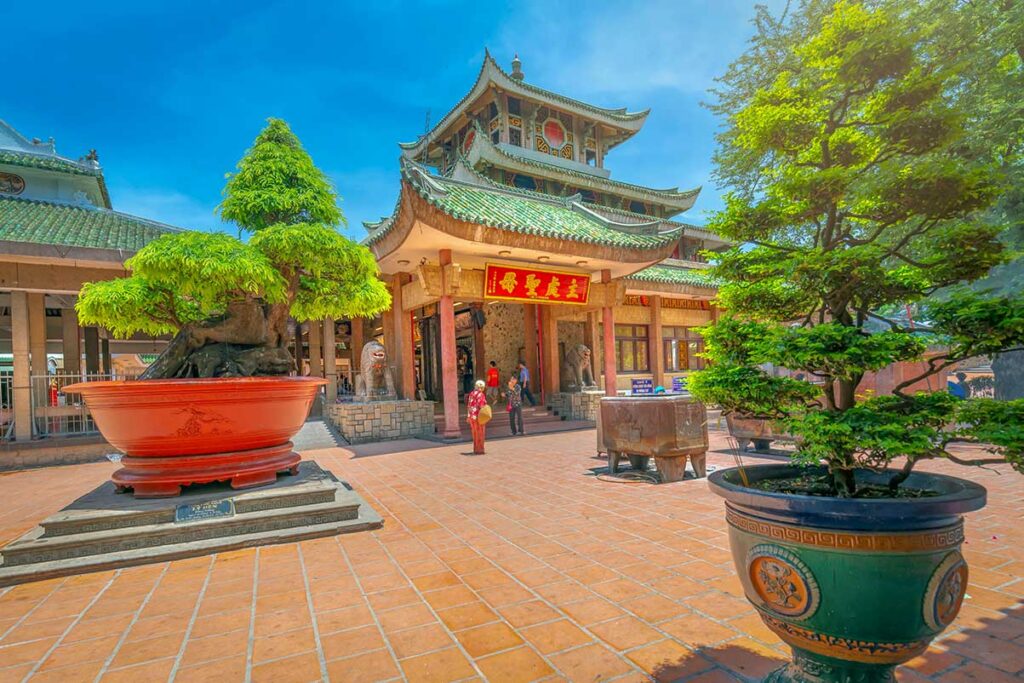
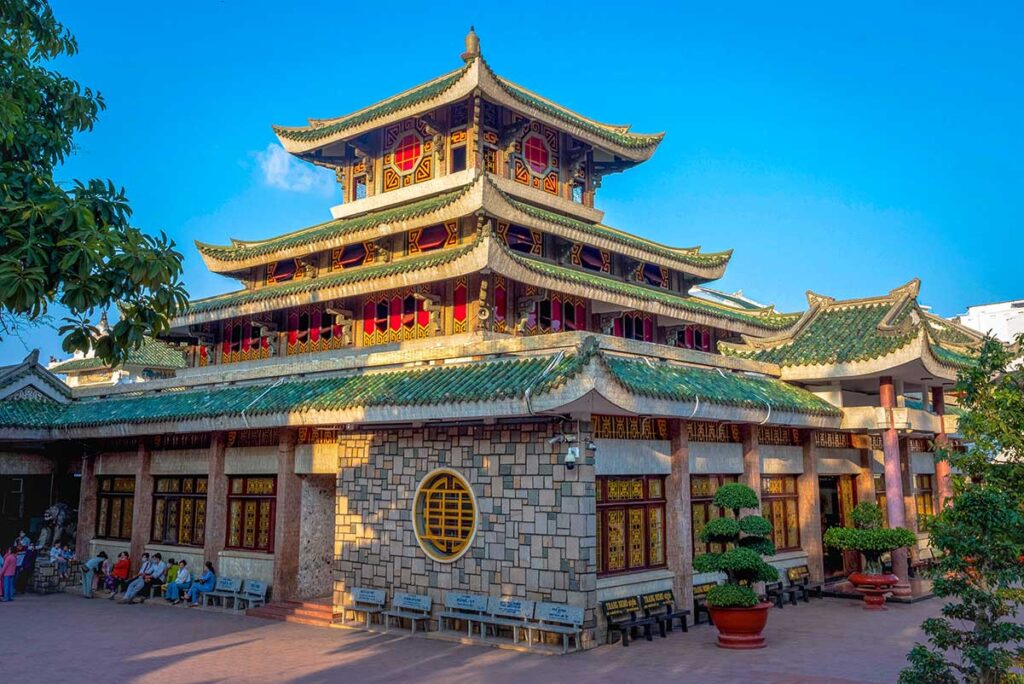
Around it are side altars, including the Council Altar in front and the Uncle (Chu) and Aunt (Co) altars to the sides. The decorations are colorful and detailed, with gilded panels, carvings, and offerings filling the space. To visitors, the interior can feel overwhelming—not because of its size, but because of the intensity of devotion and the sheer volume of offerings packed into every corner.
Highlights of visiting Ba Chua Xu Temple
1. Main hall & statue
The centerpiece of the temple is the statue of Ba Chua Xu, seated on a pedestal in the main hall and dressed in ornate robes. The atmosphere inside is thick with incense smoke, constant chanting, and a steady stream of offerings being placed before her.

It can feel crowded and intense, especially during busy times. Photography of the statue is strictly forbidden, and security guards will enforce this rule—so keep your camera tucked away inside the hall and respect the signage.
2. Offerings culture

Offerings here go far beyond the usual incense sticks and fruit trays you might see in other Vietnamese temples. Pilgrims often bring entire roasted pigs, chickens, elaborate food platters, and stacks of symbolic money. Some of these can even be rented from vendors outside the gates, used ceremonially, and then returned. Cash envelopes are also common, placed in front of the altars or into donation boxes. If you are not participating, it’s best to simply observe and step aside so pilgrims can move freely.
3. Ex-voto & gratitude displays
In side halls and upstairs rooms you’ll find countless plaques, photos, and gifts left behind by devotees whose wishes were granted. These are called ex-votos—tokens of thanks to the goddess. They range from simple wooden boards with inscriptions to elaborate framed dedications. For visitors, they highlight how central the temple is to people’s lives, especially in matters of business, health, and family.
4. Courtyard & details
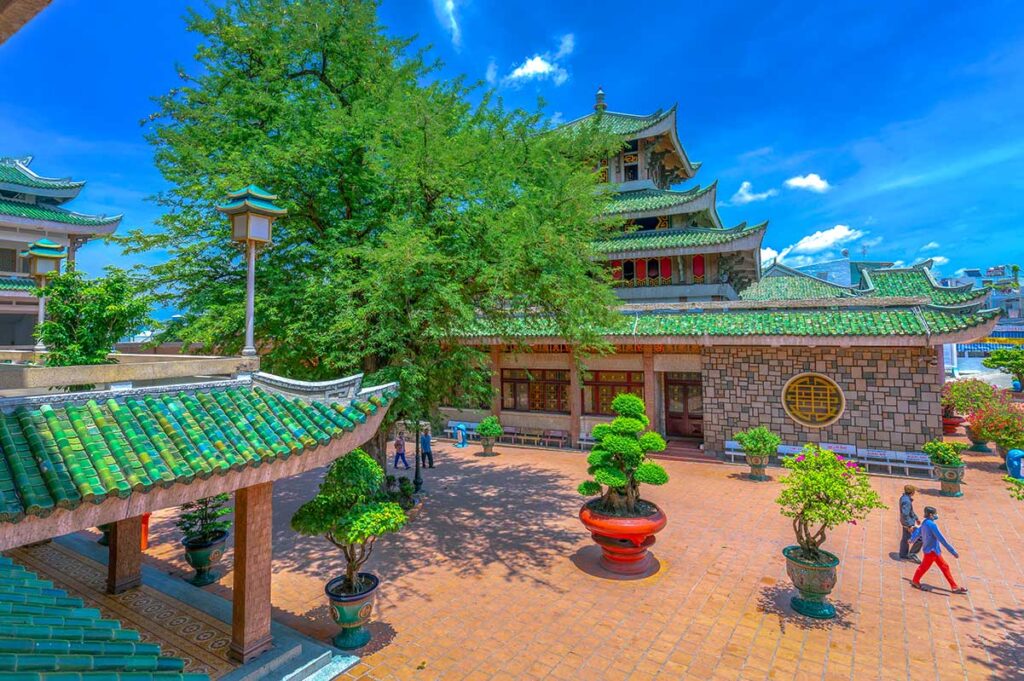
Even outside the main hall, the temple is full of details to notice. The roofs curve upward like lotus petals, walls and doors are carved and painted in bright colors, and gilded panels shimmer in the light. Lamps, incense burners, and statues fill the courtyard, where the atmosphere is slightly calmer than inside. Taking time to look closely at these features lets you appreciate the artistry without intruding on the worshippers.
5. Atmosphere & etiquette
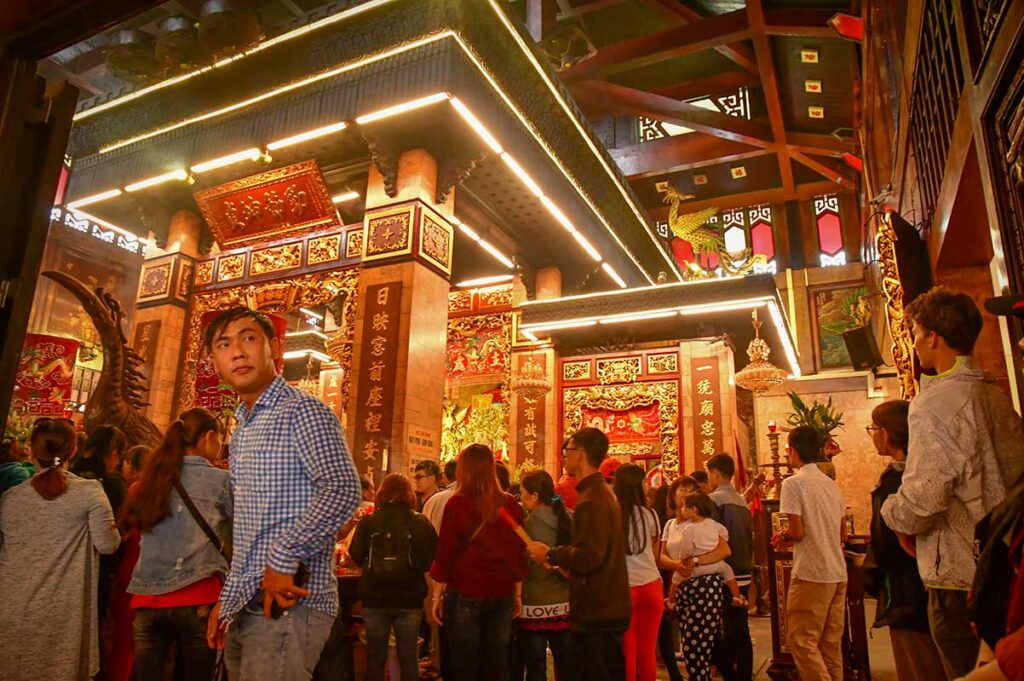
More than anything, what stands out here is the energy of a living shrine. You’ll hear drums, chanting, and constant footsteps as people shuffle through; you’ll smell incense and roasted offerings; and you’ll see pilgrims queuing patiently to make their devotions. As a visitor, the best approach is to blend in quietly: move with the flow, don’t block the altars, and keep your voice low. Tourists are a minority here, so it’s important to remember you’re stepping into a place of worship rather than a sightseeing attraction.
Ba Chua Xu Temple Festival
Each year from the 23rd to the 27th day of the fourth lunar month, Ba Chua Xu Temple becomes the center of one of southern Vietnam’s biggest religious festivals. Key rituals include a solemn procession to invite the goddess, bathing and changing her robes, and large offerings presented by the community. The crowds are immense, with thousands of pilgrims filling the temple grounds while the streets outside turn into a lively fair of food stalls, markets, and performances. If you want the full experience—or practical tips for avoiding the crush—see our dedicated Ba Chua Xu Festival guide.
What is Sam Mountain (and how Ba Chua Xu fits in)

Ba Chua Xu Temple sits right at the foot of Sam Mountain, the most important pilgrimage site in the Mekong Delta. The mountain is dotted with pagodas, shrines, and tombs, making it a spiritual landscape rather than a single attraction. Just a short walk from the temple you’ll find Tay An Pagoda with its distinctive architecture and the mausoleum of Thoai Ngoc Hau, the mandarin closely tied to Ba Chua Xu’s legends. Higher up the slopes are smaller shrines and viewpoints over the rice fields and waterways of An Giang.
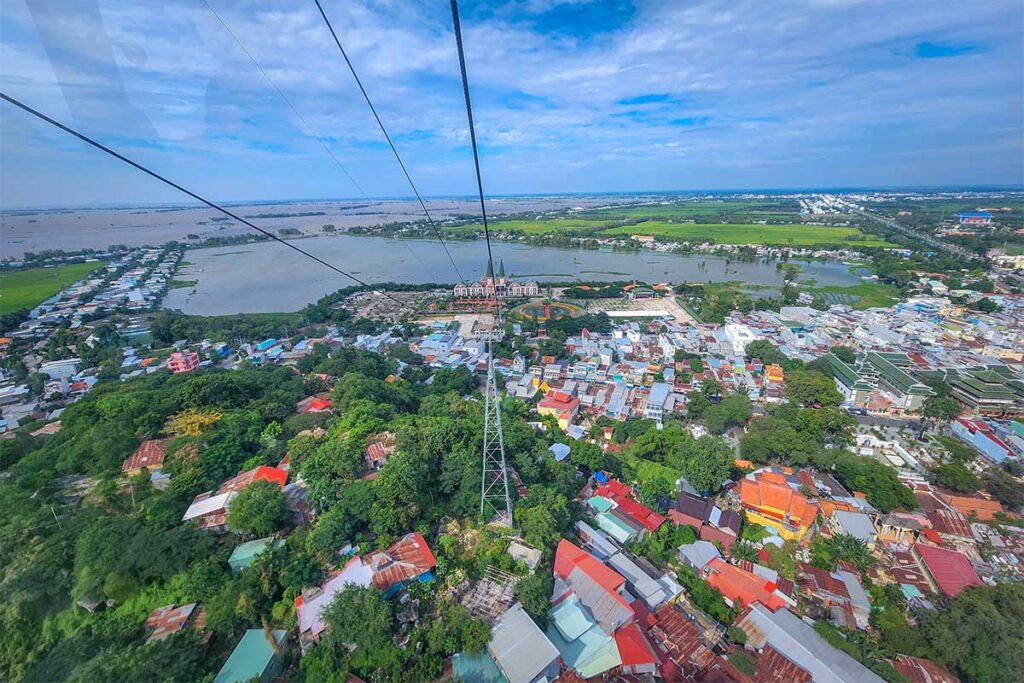
A cable car now runs up the mountain, offering an easy way to enjoy the scenery, though it’s more of a scenic add-on than a core part of visiting the temple itself. If you’re planning to explore beyond the shrine, have a look at our Complete Sam Mountain Guide for detailed tips and highlights.
Practical visiting information & tips
Location & getting there
Ba Chua Xu Temple is located at the base of Sam Mountain in Chau Doc, An Giang Province. Chau Doc is about 5–6 hours by bus or van from Ho Chi Minh City and around 3 hours from Can Tho. From Chau Doc town center it’s a short taxi, Grab, or motorbike ride to the temple, and there’s parking space near the complex if you arrive by car or motorbike.
Opening times & fees
The temple is generally open from dawn to dusk. Entry is free, though donation boxes are placed in front of the main halls if you’d like to contribute.
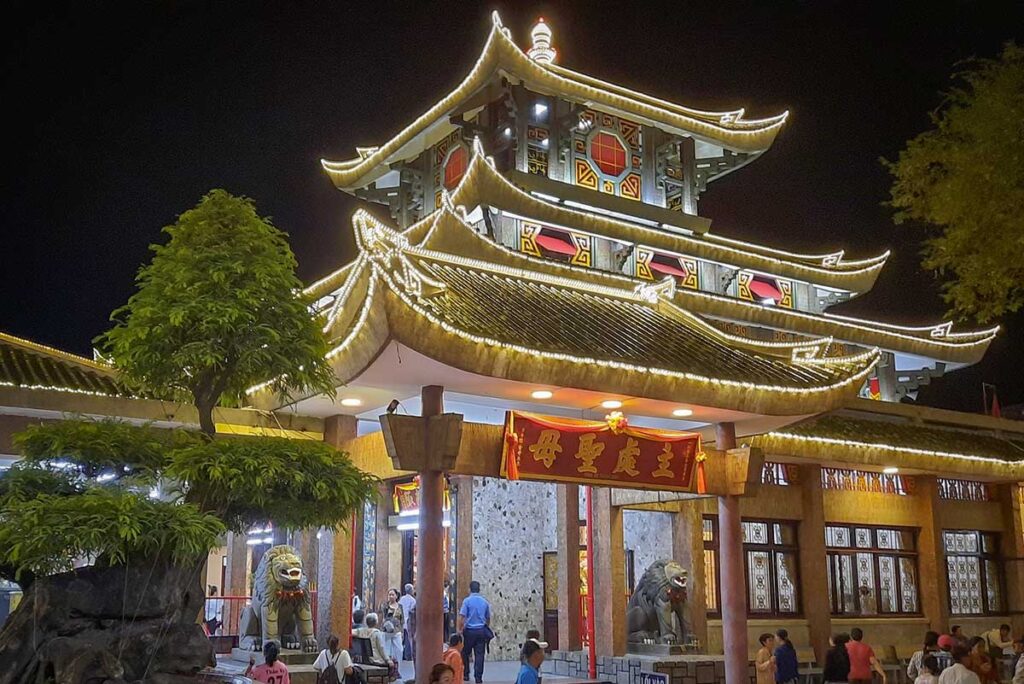
Dress code & etiquette
Wear clothing that covers your shoulders and knees. Remove hats inside the halls, keep your voice low, and follow the line of pilgrims rather than wandering freely. Never touch sacred objects or statues.
Photography rules
Photography is restricted in the main hall, especially of the statue of Ba Chua Xu. Security guards actively enforce this, so pay attention to signs. The courtyard and exterior are usually fine to photograph.
Best time to visit (avoid crowds)
Weekdays in the early morning or late afternoon are the quietest times. If you prefer to avoid large crowds, skip festival days (lunar April 23–27) and major public holidays.
Heat, hydration & footwear
Chau Doc is hot most of the year. Bring water, sun protection, and wear modest but breathable clothing. Slip-on shoes make it easier to remove them before entering halls.
Safety & scams
The temple has a reputation for pickpockets during busy periods—keep valuables secure. Ignore people trying to hand you “good luck charms” or asking for small payments. Place donations only in official temple boxes.
Accessibility
The courtyard and main halls are on flat ground, but you’ll encounter small steps and thresholds when entering prayer rooms. Shade is limited at midday, and wheelchair accessibility is partial at best.
Offerings — how to do it right
Foreign visitors are not expected to make large offerings. If you’d like to participate, buying simple flowers, incense, or fruit at fair prices is enough. Vendors outside rent large pigs and food platters, but these are meant for devotees repaying vows, not casual visitors.
Nearby sights you can combine
Within walking distance are Tay An Pagoda and the mausoleum of Thoai Ngoc Hau. In Chau Doc town, you can add the market or a riverfront stroll. For nature, the Tra Su Cajuput Forest is about a 45-minute drive away.
Services on site
Basic toilets are available, though not always easy to find. Security is present throughout the complex. Outside the gates, you’ll find markets selling offerings, souvenirs, and food, though selection is repetitive and simple.
Respectful conduct
Keep aisles clear for pilgrims, don’t step directly in front of people praying, and follow any directions from staff or security. A quiet, respectful presence goes a long way in making your visit more meaningful.
Is Ba Chua Xu Temple worth visiting?
If you’re already in Chau Doc or planning to explore Sam Mountain, Ba Chua Xu Temple is absolutely worth including. It’s not the architecture that makes it special but the atmosphere of a living shrine—pilgrims praying, offerings being carried in, and the energy of a place that genuinely matters to local people. For cultural travelers and photographers, it offers a rare look at devotion on a very large scale.
That said, it’s not a site to build an entire trip around. Coming all the way from Ho Chi Minh City just for this temple would likely be underwhelming. The real value is combining it with nearby highlights such as Tay An Pagoda, Thoai Ngoc Hau Mausoleum, or a nature stop like Tra Su Cajuput Forest. Go in with realistic expectations: it will be crowded, hot, and photography inside is limited—but if you’re curious about Vietnam’s folk religion, it’s one of the most insightful stops in the Mekong Delta.



